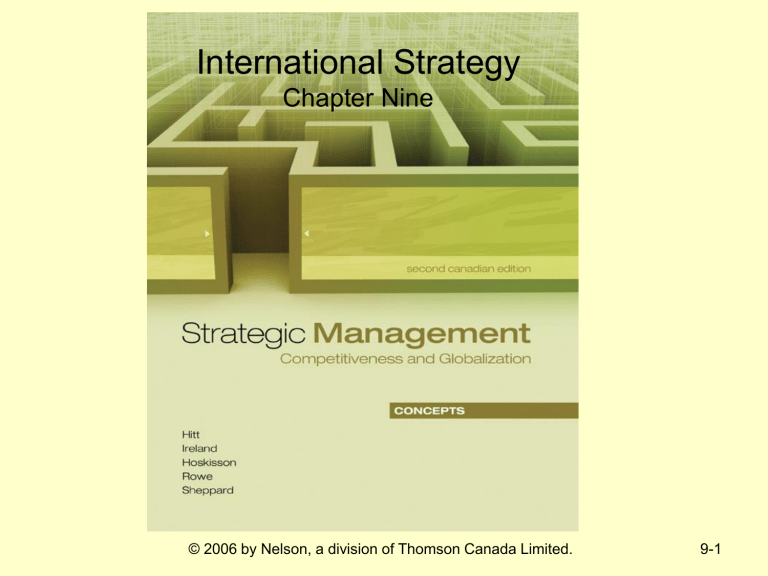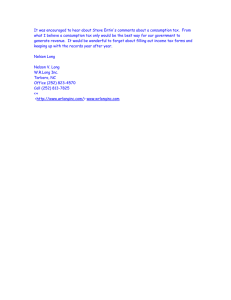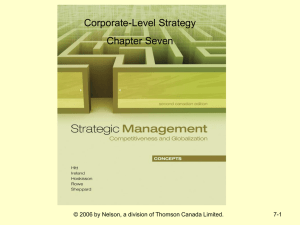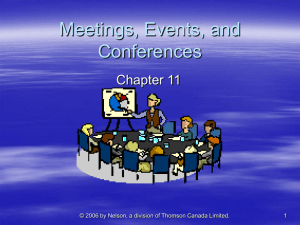
International Strategy
Chapter Nine
© 2006 by Nelson, a division of Thomson Canada Limited.
9-1
Strategic
Inputs
The Strategic
Strat. Intent
Management
Process
.
Chapter 4
Internal
Environment
Strat. Mission
Strategy Formulation
Chapter 5
Bus. - Level
Strategy
Chapter 6
Chapter 7
Competitive Corp. - Level
Dynamics
Strategy
Chapter 9
Chapter 8
Acquisitions & International
Strategy
Restructuring
Strategic
Outcomes
Strategic Actions
Chapter 3
External
Environment
Chapter 2
Above Average
Returns
Chapter 10
Cooperative
Strategies
Chapter 1
Strategic
Competitiveness
Strategy Implementation
Chapter 11
Chapter 12
Corporate
Structure
Governance
& Control
Chapter 13 Chapter 14
Strategic Entrepreneurship
Leadership & Innovation
Feedback
© 2006 by Nelson, a division of Thomson Canada Limited.
9-2
International Strategy
Knowledge Objectives
1.
Understand why firms pursue international
diversification.
2.
Define the three international corporate-level
strategies: multidomestic, global, and transnational.
3.
4.
Understand risk of international expansion
Name & describe the five alternative modes for
entering international markets
Understand importance of factor, demand and related
and supporting industries of target Country
5.
© 2006 by Nelson, a division of Thomson Canada Limited.
9-3
Benefits of International Strategies
• Increased market size.
• Greater returns on major capital investments or new
products or processes.
• Greater economies of scale, scope or learning.
• A competitive advantage through location.
• Trade across nations will exceed trade within nations
• Rise of market capitalism around the world
© 2006 by Nelson, a division of Thomson Canada Limited.
9-4
Population of Selected
Nations
Country
May 2005 (estimated)
China
India
United States
Japan
Germany
World Total
1,305,034,000
1,077,886,000
295,280,000
127,418,000
82,438,000
6,379,157,000
Exhibit 7.2 Populations of Selected Nations
Source: www.geohive.com/global/pop_data2.php.
McGraw-Hill/Irwin
Strategic Management, 3/e
© 2006 by Nelson, a division of Thomson Canada Limited.
9-5
Copyright © 2007 The McGraw-Hill Companies, Inc. All rights reserved.
International Strategy Opportunities & Outcomes
Identify
International
Opportunities
Explore
Resources &
Capabilities
Use Core
Competence
International
Modes of
Entry
Strategies
Increased
Market Size
Return on
Investment
Economies
of Scale and
Learning
Location
Advantage
International
Bus.-Level
Strategy
Multidomestic
Strategy
Global
Strategy
Transnational
Strategy
Strategic
Competitiveness
Outcomes
Exporting
Management
Problems, Risk,
and First Steps
Higher
Performance
Returns
Licensing
Strategic
Alliances
Acquisition
Innovation
Establishment
of New Sub.
Management
Problems, Risk,
and First Steps
© 2006 by Nelson, a division of Thomson Canada Limited.
9-6
Determinants of National Advantage
© 2006 by Nelson, a division of Thomson Canada Limited.
9-7
Porter’s Diamond of National
Advantage:
As Applied to India
Adapted from Exhibit 7.1 India’s Virtual Diamond in Software
McGraw-Hill/Irwin
Strategic Management, 3/e
© 2006 by Nelson, a division of Thomson Canada Limited.
9-8
Copyright © 2007 The McGraw-Hill Companies, Inc. All rights reserved.
Determinants of National Advantage
• Factors of Production
– Inputs – Labour, land, natural resources, capital & infrastructure
• Demand Conditions
– The nature and size of he buyers needs in the home market of
goods & services
• Related & Supporting Industries
– Industries in which the target country is considered the leader
eg. Italy - shoes with a supporting leather industry,
Japan - cameras & photocopiers,
Denmark - diary & an industry focused on food enzymes.
• Firm Strategy, Structure & Rivalry make up
– Germany focused on methodical product & process improvements,
– Italy’s national pride of designers helped spawn fashion apparel,
furniture & sports car industries.
© 2006 by Nelson, a division of Thomson Canada Limited.
9-9
International Corporate-Level Strategy
© 2006 by Nelson, a division of Thomson Canada Limited.
9-10
International Corporate-Level Strategy
• Multi-domestic Strategy
– Strategic & operating decisions are decentralized to the
strategic business unit in each country to tailor products
to the local market.
• Global Strategy
– Strategic & operating decisions are centralized. Products
are standardized. There are only a few manufacturing
locations with long production runs.
• Transnational Strategy
– A combination of the multi-domestic and global strategies.
The most profitable of all of them.
© 2006 by Nelson, a division of Thomson Canada Limited.
9-11
Strengths and Limitations of Various
Strategies
Strategy
Strengths
Global
Strong integration across Limited ability to adapt to
various businesses.
local markets.
Standardization leads to
Concentration of activities
higher economies of scale
may increase dependence
which lowers costs.
on a single facility.
Helps to create uniform
Single locations may lead to
standards of quality
higher tariffs and
throughout the world.
transportation costs.
McGraw-Hill/Irwin
Strategic Management, 3/e
Limitations
7.6 Strengths and Limitations of Various Strategies
© 2006 by Nelson, a division of ThomsonExhibit
Canada
Limited.
9-12
Copyright © 2007 The McGraw-Hill Companies, Inc. All rights reserved.
Strengths and Limitations of Various
Strategies
Strategy
Strengths
Limitations
Multidomestic Ability to adapt products
and services to local
market conditions.
Ability to detect potential
opportunities for attractive
niches in a given market,
enhancing revenue.
Less ability to realize cost
savings through scale
economies.
Greater difficulty in
transferring knowledge
across countries.
May lead to “overadaptation”
as conditions change.
Transnational Ability to attain economies Unique challenges in
of scale.
determining optimal locations
of activities to ensure cost
Ability to adapt to local
and quality.
markets.
Unique managerial
Ability to locate activities
challenges in fostering
in optimal locations.
knowledge transfer.
Ability to increase
knowledge flows and
learning.
McGraw-Hill/Irwin
Strategic Management, 3/e
Exhibit 7.6 Strengths and Limitations of Various Strategies
© 2006 by Nelson, a division of Thomson Canada Limited.
9-13
Copyright © 2007 The McGraw-Hill Companies, Inc. All rights reserved.
Entry Modes of International
Expansion
Wholly Owned
Subsidiary
Extent of Investment Risk
High
Joint Venture
Strategic Alliance
Franchising
Licensing
Exporting
Low
Low
High
Degree of Ownership and Control
McGraw-Hill/Irwin
Strategic Management, 3/e
Adapted from Exhibit 7.7 Entry Modes for International Expansion
© 2006 by Nelson, a division of Thomson Canada Limited.
9-14
Copyright © 2007 The McGraw-Hill Companies, Inc. All rights reserved.
Strategic Competitiveness Outcomes
International diversification facilitates
innovation in the firm.
Provides larger market to gain more and faster
returns form investments in innovation.
May generate resources necessary to sustain a
large-scale R&D program.
Generally related to above-average returns,
assuming effective implementation and
management of international operations.
International diversification provides greater
economies of scope and learning.
© 2006 by Nelson, a division of Thomson Canada Limited.
9-15
International Strategy Opportunities & Outcomes
Identify
International
Opportunities
Explore
Resources &
Capabilities
Use Core
Competence
International
Modes of
Entry
Strategies
Increased
Market Size
Return on
Investment
Economies
of Scale and
Learning
Location
Advantage
International
Bus.-Level
Strategy
Multidomestic
Strategy
Global
Strategy
Transnational
Strategy
Strategic
Competitiveness
Outcomes
Exporting
Management
Problems, Risk,
and First Steps
Higher
Performance
Returns
Licensing
Strategic
Alliances
Acquisition
Innovation
Establishment
of New Sub.
Management
Problems, Risk,
and First Steps
© 2006 by Nelson, a division of Thomson Canada Limited.
9-16
Risks in the International Environment
© 2006 by Nelson, a division of Thomson Canada Limited.
9-17
Major Risks of
International Diversification
Political Risk
National government instability may create
potential problems for internationally
diversified firms.
Potential changes in attitudes or
regulations regarding foreign ownership.
Legal authority obtained from previous
administration may become invalid.
Potential for nationalization of firms’ assets.
© 2006 by Nelson, a division of Thomson Canada Limited.
9-18
Major Risks of International
Diversification
Economic Risk
Econ. risks are interdependent with political risks.
Differences and fluctuations in international
currencies may affect value of assets & liabilities.
This affects prices & thus ability to compete.
Differences in inflation rates may affect internationally diversified firms’ ability to compete.
Enforcing intellectual property rights on CDs,
software, etc.
© 2006 by Nelson, a division of Thomson Canada Limited.
9-19






